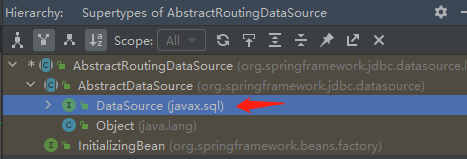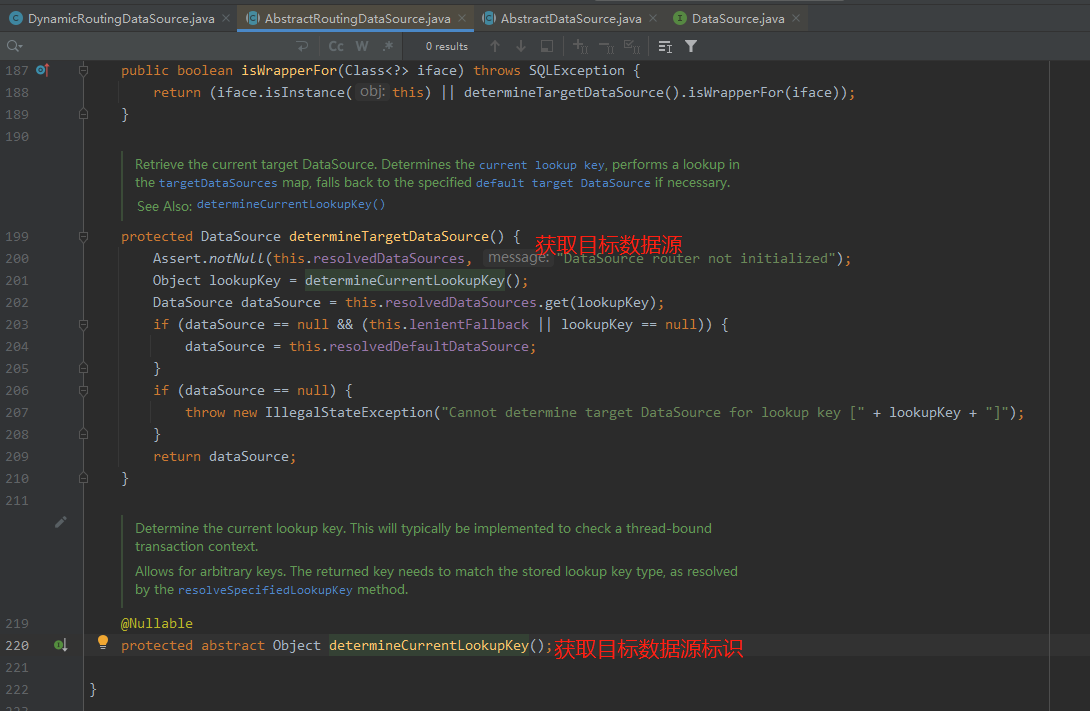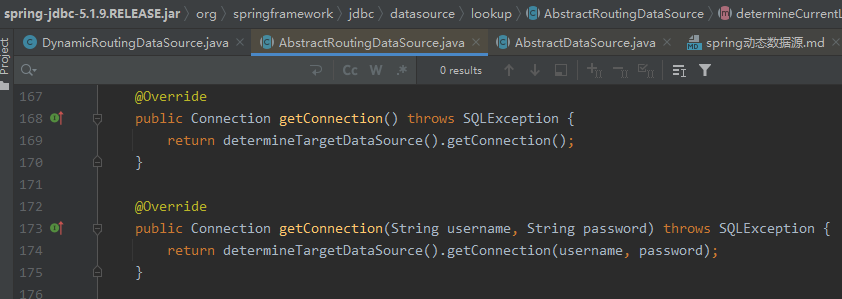

spring多数据源动态切换的实现原理及读写分离的应用 - 京东云技术团队
source link: https://www.cnblogs.com/jingdongkeji/p/17616194.html
Go to the source link to view the article. You can view the picture content, updated content and better typesetting reading experience. If the link is broken, please click the button below to view the snapshot at that time.

spring多数据源动态切换的实现原理及读写分离的应用
AbstractRoutingDataSource是Spring框架中的一个抽象类,可以实现多数据源的动态切换和路由,以满足复杂的业务需求和提高系统的性能、可扩展性、灵活性。
- 多租户支持:对于多租户的应用,根据当前租户来选择其对应的数据源,实现租户级别的隔离和数据存储。
- 分库分表:为了提高性能和扩展性,将数据分散到多个数据库或表中,根据分片规则来选择正确的数据源,实现分库分表。
- 读写分离:为了提高数据库的读写性能,可能会采用读写分离的方式,根据读写操作的类型来选择合适的数据源,实现读写分离。
- 数据源负载均衡:根据负载均衡策略来选择合适的数据源,将请求均匀地分配到不同的数据源上,提高系统的整体性能和可伸缩性。
- 多数据库支持:在一些场景下,可能需要同时连接多个不同类型的数据库,如关系型数据库、NoSQL数据库等。根据业务需求选择不同类型的数据源,实现对多数据库的支持。
1.AbstractRoutingDataSource实现了DataSource接口,作为一个数据源的封装类,负责路由数据库请求到不同的目标数据源

2.该类中定义了一个determineTargetDataSource方法,会获取当前的目标数据源标识符,进而返回真正的数据源;
值得注意的是:其中determineCurrentLookupKey为抽象方法,明显是要让用户自定义实现获取数据源标识的业务逻辑。

3.当系统执行数据库操作之前,会先获取数据源链接,即调用getConnection方法,该类重写的getConnection方法,会获取到真正的目标数据源,进而将数据库操作委托给目标数据源进行处理。

读写分离实现V1版
- yml中配置主从数据库连接信息
spring:
datasource:
business-master:
url: jdbc:mysql://ip1:3306/xxx
username: c_username
password: p1
business-slaver:
url: jdbc:mysql://ip2:3306/xxx
username: c_username
password: p2
2.读取yml中的主从数据源配置
@Data
@ConfigurationProperties(prefix = "spring.datasource")
@Component
public class DataSourcePropertiesConfig {
/**
* 主库配置
*/
DruidDataSource businessMaster;
/**
* 从库配置
*/
DruidDataSource businessSlaver;
}
3.自定义动态数据源类DynamicRoutingDataSource,继承AbstractRoutingDataSource类,并重写determineCurrentLookupKey方法,定义获取目标数据源标识的逻辑。
此处的逻辑为:定义一个DataSourceHolder类,将数据源标识放到ThreadLocal中,当需要时从ThreadLocal中获取。
public class DynamicRoutingDataSource extends AbstractRoutingDataSource {
/**
* 获取目标数据源标识
*/
@Override
protected Object determineCurrentLookupKey() {
return DataSourceHolder.getDbName();
}
}
public class DataSourceHolder {
/**
* 当前线程使用的 数据源名称
*/
private static final ThreadLocal<String> THREAD_LOCAL_DB_NAME = new ThreadLocal<>();
/**
* 设置数据源名称
*/
public static void setDbName(String dbName) {
THREAD_LOCAL_DB_NAME.set(dbName);
}
/**
* 获取数据源名称,为空的话默认切主库
*/
public static String getDbName() {
String dbName = THREAD_LOCAL_DB_NAME.get();
if (StringUtils.isBlank(dbName)) {
dbName = DbNameConstant.MASTER;
}
return dbName;
}
/**
* 清除当前数据源名称
*/
public static void clearDb() {
THREAD_LOCAL_DB_NAME.remove();
}
}
4.创建动态数据源DynamicRoutingDataSource对象,并注入到容器中。这里创建了主从两个数据源,并进行了初始化,分别为其设置了数据源标识并放到了DynamicRoutingDataSource对象中,以便后面使用。
若为多个数据源,可参考此处进行批量定义。
@Configuration
public class DataSourceConfig {
@Autowired
private DataSourcePropertiesConfig dataSourcePropertiesConfig;
/**
* 主库数据源
*/
public DataSource masterDataSource() throws SQLException {
DruidDataSource businessDataSource = dataSourcePropertiesConfig.getBusinessMaster();
businessDataSource.init();
return businessDataSource;
}
/**
* 从库数据源
*/
public DataSource slaverDataSource() throws SQLException {
DruidDataSource businessDataSource = dataSourcePropertiesConfig.getBusinessSlaver();
businessDataSource.init();
return businessDataSource;
}
/**
* 动态数据源
*/
@Bean
public DynamicRoutingDataSource dynamicRoutingDataSource() throws SQLException {
DynamicRoutingDataSource dynamicRoutingDataSource = new DynamicRoutingDataSource();
Map<Object, Object> targetDataSources = new HashMap<>(2);
targetDataSources.put("master", masterDataSource());
targetDataSources.put("slaver", slaverDataSource());
dynamicRoutingDataSource.setDefaultTargetDataSource(masterDS);
dynamicRoutingDataSource.setTargetDataSources(targetDataSources);
dynamicRoutingDataSource.afterPropertiesSet();
return dynamicRoutingDataSource;
}
}
5.自定义一个注解,指定数据库。
可以将一些常用的查询接口自动路由到读库,以减轻主库压力。
@Documented
@Inherited
@Target({ElementType.METHOD})
@Retention(RetentionPolicy.RUNTIME)
public @interface DataSourceSwitch {
/**
* 数据源名称,默认主库
*/
String dbName() default "master";
}
6.定义一个切面,拦截所有Controller接口,使用DataSourceSwitchRead注解的方法,将统一路由到读库查询
@Aspect
@Component
@Slf4j
public class DataSourceAspect {
/**
* 切库,若为多个从库,可在这里添加负载均衡策略
*/
@Before(value = "execution ( * com.jd.gyh.controller.*.*(..))")
public void changeDb(JoinPoint joinPoint) {
Method m = ((MethodSignature) joinPoint.getSignature()).getMethod();
DataSourceSwitch dataSourceSwitch = m.getAnnotation(DataSourceSwitch.class);
if (dataSourceSwitch == null) {
DataSourceHolder.setDbName(DbNameConstant.MASTER);
log.info("switch db dbName = master");
} else {
String dbName = dataSourceSwitch.dbName();
log.info("switch db dbName = {}", dbName);
DataSourceHolder.setDbName(dbName);
}
}
}
作者:京东科技 郭艳红
来源:京东云开发者社区
Recommend
About Joyk
Aggregate valuable and interesting links.
Joyk means Joy of geeK